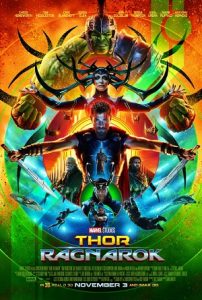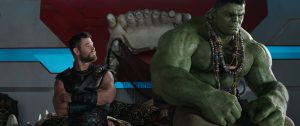 Few would argue that the previous “Thor” films have been among the weaker entries in an otherwise strong Marvel cinematic universe. Statistics and graphs seemed to indicate that the God of Thunder’s chief selling point to unfamiliar audiences consisted of standard fantasy tropes; these were repackaged for viewers spun up on “Lord of the Rings” and “Game of Thrones,” despite neither being representative of Stan Lee and Jack Kirby’s original vision, to say nothing of what creators like Walt Simonson would later do with the character. Trust me on this. I know what I’m talking about. While you were on the playground during recess or attending the school dance, I was hiding in the media center and arguing about this crap, as well as related crap of equal importance to a thirteen year-old. Congratulations, and welcome to the ongoing nightmare of my perpetual adolescence, immortalized here for you to savor and enjoy.
Few would argue that the previous “Thor” films have been among the weaker entries in an otherwise strong Marvel cinematic universe. Statistics and graphs seemed to indicate that the God of Thunder’s chief selling point to unfamiliar audiences consisted of standard fantasy tropes; these were repackaged for viewers spun up on “Lord of the Rings” and “Game of Thrones,” despite neither being representative of Stan Lee and Jack Kirby’s original vision, to say nothing of what creators like Walt Simonson would later do with the character. Trust me on this. I know what I’m talking about. While you were on the playground during recess or attending the school dance, I was hiding in the media center and arguing about this crap, as well as related crap of equal importance to a thirteen year-old. Congratulations, and welcome to the ongoing nightmare of my perpetual adolescence, immortalized here for you to savor and enjoy.
The four-color adventures of Thor were less about what we commonly associate with “Dungeons & Dragons” than they were a hybrid of disparate genres, fusing classical mythology, Robert E. Howard-style fantasy, and early 20th century science fiction. In fact, if one were to describe the Thor who appears in the pages of Marvel Comics to an ironic, nostalgia-drenched Millennial educated by endless listicles on Cracked.com and Buzzfeed, then the most accurate point of comparison would be He-Man. You know: the cartoon with the trippy Frazetta-lite designs and a hero whose streetwear consisted of a pink vest, purple tights, and a fur diaper? Yes, that He-Man. “I have the power,” indeed.
Questionable wardrobe aside, the heroic adventures depicted by Filmation were in many ways Thor in all but name, from the fusion of clashing archetypes (He-Man has a sword but his allies fly ships and shoot guns), to the concept of a nebbish-y everyman (Prince Adam, Donald Blake) carrying, in secret, an ancient weapon (sword, hammer) that unlocked and revealed his alter-ego. Cheesy Orko life lessons aside, “He-Man and the Masters of the Universe” was probably closer to the Stan Lee source material than either live action “Thor” film produced by Marvel Studios this decade.
It’s tempting to point to the breakout success of the decidedly retro, hypercolor “Guardians of the Galaxy” duology as a conscious course-correction for the “Thor” franchise (particularly given the latter’s sudden shift into self-aware comedic trappings, and the liberal use of classic rock tracks like “The Immigrant Song”), but Taika Waititi’s “Ragnarok” manages to feel both new to general audiences and familiar to fans of the character at the same time. Between the junkyard pastiche of disparate visual genre elements, and the hitherto unmined aspects of the hero and his supporting cast, “Thor: Ragnarok” is not only the most conceptually daring Marvel product to date, but it’s also the funniest film of the year, period.
 The balance between awe-inspiring heroics and self-effacing comedy — whether on the page or the silver screen — has always been Marvel’s secret weapon; and like most successful formulas, the attempt by competitors to replicate its success often yields questionable, if not catastrophic, results (DC, I’m looking at right at you). In this case, Waititi has been given free reign to indulge his irreverence and push the thematic aspects to eleven, resulting in a film that’s both bold and perpetually self-aware. It’s like Cannon Films hired a director with talent, ponied up more than five dollars, and told him to make a movie that felt like “Flash Gordon,” looked a “Thor” comic, and had its entire middle section scored with synthesizers. If you dig Comic Book Movies, you’ll dig “Thor: Ragnarok,” and if you don’t, the movie will charm you in spite of yourself.
The balance between awe-inspiring heroics and self-effacing comedy — whether on the page or the silver screen — has always been Marvel’s secret weapon; and like most successful formulas, the attempt by competitors to replicate its success often yields questionable, if not catastrophic, results (DC, I’m looking at right at you). In this case, Waititi has been given free reign to indulge his irreverence and push the thematic aspects to eleven, resulting in a film that’s both bold and perpetually self-aware. It’s like Cannon Films hired a director with talent, ponied up more than five dollars, and told him to make a movie that felt like “Flash Gordon,” looked a “Thor” comic, and had its entire middle section scored with synthesizers. If you dig Comic Book Movies, you’ll dig “Thor: Ragnarok,” and if you don’t, the movie will charm you in spite of yourself.
As with most Marvel films, it’s all so interconnected that it’s impossible to give a synopsis without referencing all fifty films that precede it; but the upshot is that Thor (Chris Hemsworth) and his half-brother Loki (Tom Hiddleston) discover they have a sister named Hela (Cate Blanchette), who just happens to be the Goddess of Death. Hela signals Ragnarok – the fall of the cosmic realm of Asgard – and in doing so breaks Thor’s hammer. Through a series of misadventures, our hero rubs shoulders with Doctor Strange (Benedict Cumberbatch), becomes a gladiator engaged in an arena battle with the Hulk (Mark Ruffalo), and has his hair shorn off by none other than Stan “The Man” Lee himself. Will Thor escape the junk planet of Sakaar and its quasi-Eurotrash Grandmaster (Jeff Goldblum)? Can he, Loki, the Hulk, and newcomer Valkyrie (Tessa Thompson) prevent the total annihilation of the people of Asgard? Has Cate Blanchett ever so successfully rocked an outfit as she does here, playing a gothed-out witch in skin-tight black leather? And wait, is that seriously Matt Damon cameo-ing in a “Thor” movie? The answer to all of the above is “yes,” except the question about Blanchett, which is a resounding NO.
Much of what makes “Ragnarok” so successful is its ensemble nature. Blanchett is fun but unfortunately underserved; hopefully her relationship with Thanos in “Infinity War” offers her greater room to have fun with a performance that perfectly straddles the line between camp and opera. Karl Urban – arguably one of the best working character actors alive right now – turns in a performance as an Asgardian turncoat named Skurge that allows him to explore both hilarious incompetency and irreconcilable conflict. Tessa Thompson’s Valkyrie balances badassery with self-effacing humor, and even Anthony Hopkins gets to mutter “Oh, shit!” at one point.
 As good as the main players are, they’re all upstaged by Goldblum, who brings so much to so minor a role that he literally dominates the screen every time he’s on it, edging everyone else out of frame. Likewise, Ruffalo’s newly-verbal Hulk turns the roaring green monster into a tantrum-throwing adolescent, allowing him moments with Thor that among the film’s best. “You’re a bad friend!” Thor shouts, to which the Hulk screams, “No, YOU’RE a bad friend!” as the two throw furniture at one another. “You’re just using me to get to the Hulk,” Banner moans to Thor later when solicited for help escaping Sakkar. “That’s gross.” This ain’t no Ang Lee joint, guys.
As good as the main players are, they’re all upstaged by Goldblum, who brings so much to so minor a role that he literally dominates the screen every time he’s on it, edging everyone else out of frame. Likewise, Ruffalo’s newly-verbal Hulk turns the roaring green monster into a tantrum-throwing adolescent, allowing him moments with Thor that among the film’s best. “You’re a bad friend!” Thor shouts, to which the Hulk screams, “No, YOU’RE a bad friend!” as the two throw furniture at one another. “You’re just using me to get to the Hulk,” Banner moans to Thor later when solicited for help escaping Sakkar. “That’s gross.” This ain’t no Ang Lee joint, guys.
However, it’s the lead who’s finally given the most room to shine. Hemsworth has demonstrated his comedic timing elsewhere; here, he’s given the freedom to run with it, whether during a confrontation with a villain while dangling from a chain that is slowly spinning him in circles, or in the delivery of non sequiturs that somehow manage to land every time. “One time, he turned himself into a snake,” he says of Loki. “Well he knows I love snakes, so I went to pick it up. Then he turned into himself again and was all like ‘Ahhh’, and then he stabbed me. We were eight at the time.” During moments such as these, I can imagine a seething thirteen year-old version of myself sitting in the Media Center and exploding over the violation of so noble and stoic a character; then I just sort of mentally shout backward through time for him to get over himself and go back to enjoying the movie.
“Thor: Ragnarok” is essentially two films: the one you’ve seen in the trailers, which is hilarious and fun, and the other, which is the high-minded stylized fantasy of the previous installments. Both work. Marvel mastermind Kevin Feige has kept a close eye on his cinematic universe, and has retained a certain brand sensibility when creating the sausage (though one that detractors have criticized as yirlding little more than assembly line product); but bringing in directors like Waititi, James Gunn, and the Russo Brothers has allowed quirk to enter the superhero formula. Enlisting filmmakers who are casual fans rather than slavish line-tracers, and then giving them latitude to explore within clearly defined parameters, is resulting in Marvel’s continued growth, seen throughout this past year in “Guardians of the Galaxy Vol. 2” and “Spider-Man: Homecoming”; “Thor: Ragnarok” continues the 2017 trend of fulfilling commercial interests with a pseudo-indie sensibility.
More than that, though, it’s the perfect date movie for guys who normally have to drag their wives and girlfriends along to these sort of things and then listen to them complain about it for the rest of the night. After all, it’s got Hemsworth’s bare, oiled chest, contrasted with Hiddleston’s fey schtick for the ladies who like their Jane Austen; even the Hulk gets an ass shot, because of course he should. If thirteen year-old Erik receives any consolation that both the “Ragnarok” and “Planet Hulk” storylines have been distilled into a Hollywood comedy, it’s that maybe he could actually get a date to see a Comic Book Movie with him, provided he ventured outside of the Media Center once in a while.
Directed by Taika Waititi
Written by Eric Pearson
Rated PG-13 for intense sequences of sci-fi violence and action, and brief suggestive material



Leave a Reply
You must be logged in to post a comment.